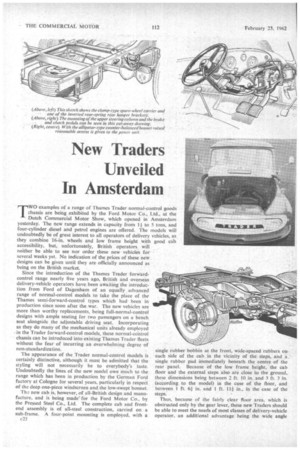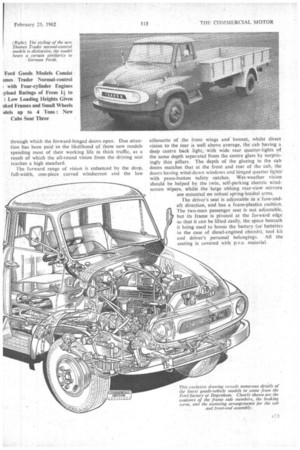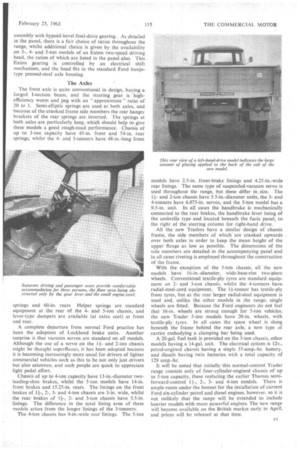New Traders Unveiled In Amsterdam
Page 62

Page 63

Page 64

Page 71

If you've noticed an error in this article please click here to report it so we can fix it.
TWO examples of a range of Thames Trader normal-control goods chassis are being exhibited by the Ford Motor Co., Ltd., at the Dutch Commercial Motor Show, which opened in Amsterdam yesterday. The new range extends in capacity from 14 to 5 tons, and four-cylinder diesel and petrol engines are offered. The models will undoubtedly be of great interest to all operators of delivery vehicles, as they combine 16-in, wheels and low frame height with good cab accessibility, but, unfortunately, British operators will neither be able to see nor order these new vehicles for several weeks yet. No indication of the prices of these new designs can be given until they are officially announced as being on the British market.
Since the introduction of the Thames Trader forwardcontrol range nearly five years ago, British and overseas delivery-vehicle operators have been awaiting the introduction from Ford of Dagenham of an equally advanced range of normal-control models to take the place of the Thames semi-forward-control types which had been in production since soon after the war. The new vehicles are more than worthy replacements, being full-normal-control designs with ample seating for two passengers on a bench seat alongside the adjustable driving seat. Incorporating as they do many of the mechanical units already employed in the Trader forward-control models, these normal-control chassis can be introduced into existing Thames Trader fleets without the fear of incurring an overwhelming degree of non-standardization.
The appearance of the Trader normal-control models is certainly distinctive, although it must be admitted that the styling will not necessarily be to everybody's taste. Undoubtedly the lines of the new model owe much to the range which has been in production by the German Ford factory at Cologne for several years, particularly in respect of the deep one-piece windscreen and the low-swept bonnet.
The new cab is. however, of all-British design and manufacture, and is being made for the Ford Motor Co., by the Pressed Steel Co., Ltd. The complete cab and frontend assembly is of all-steel construction, carried on a sub-frame. A four-point mounting is employed, with a c22 single rubber bobbin at the front, wide-spaced rubbers on each side of the cab in the vicinity of the steps, and a single rubber pad immediately beneath the centre of the rear panel. Because of the low frame height, the cab floor and the external steps also are close to the ground, these dimensions being between 2 ft. 10 in. and 3 ft. 3 in. (according to the model) in the case of the floor, and between 1 ft. 61 in. and 1 ft. 11.1 in., in the case of the steps.
Thus, because of the fairly clear floor area, which is obstructed only by the gear lever, these new Traders should be able to meet the needs of most dasse.s of delivery-vehicle operator, an additional advantage being the wide angle through which the forward-hinged doors open. Due attention has been paid to the likelihood of these new models spending most of their working life in thick traffic, as a result of which the all-round vision from the driving seat reaches a high standard.
The forward range of vision is enhanced by the deep, full-width, one-piece curved windscreen and the low silhouette of the front wings and bonnet, whilst direct vision to the rear is well above average, the cab having a deep centre back light, with wide rear quarter-lights of the same depth separated from the centre glass by surprisingly thin pillars. The depth of the glazing in the cab doors matches that at the front and rear of the cab, the doors having wind-down windows and hinged quarter light with press-button safety catches. Wet-weather vision should be helped by the twin, self-parking electric windscreen wipers, whilst the large oblong rear-view mirrors are mounted on robust spring-loaded arms.
The driver's seat is adjustable in a fore-andaft direction, and has a foam-plastics cushion. The two-man passenger seat is not adjustable, but its frame is pivoted at the forward edge so that it can be lifted easily, the space beneath it being used to house the battery (or batteries in the case of diesel-engined chassis), tool kit and driver's personal belongings. All the seating is covered with p.v.c. material. There is no enclosed. glove locker in the new cab, but the facia-panel pressing is concave in section so that it forms a dished shelf extending from the passenger-door pillar to the instrument nacelle: this arrangement applies to both leftand right-hand drive models.
The instrument cluster housed in the hooded nacelle incorporates speedometer, odometer, fuel gauge, temperature gauge and, in the case of diesel models, a vacuum gauge. Oil-pressure, generator-charging and main-beam warning lights are incorporated, and the starter-motor switch is included in the ignition/master switch, which is key operated. The side, head and tail lamps are controlled by a rotary switch on the end of a stalk projecting from the right-hand side of the steering column, this switch containing the horn button, also. The optional flashing direction indicators are controlled by a lever on the opposite side of the column. Other cab fittings include a single sun visor and an interior light mounted centrally above the rear windows.
In The Cab On looking into the cab for the first time one is immediately struck by the angle of the steering wheel, which is more like that to be found in a forward-control vehicle. This again reveals signs 'of Continental thought, as this type of steering-wheel location is frequently encountered on, say, German normaland semi-forward-control vehicles. The wheel lies at an angle of 340 to the horizontal and at this angle it cannot, of course, be linked to the steering box by. a solid inner column, so the wheel is attached to a short shaft which carries a universal joint. Below this joint there is a longer shaft running at a reduced angle straight to the frame-mounted steering box and connected to that box through a flexible coupling.
The steering wheel has a diameter of 19.75 in., and is of the " dished " type. Its size and angle, however, bring it rather close to the driving seat, and British drivers of the old school will undoubtedly find the driving position somewhat strange to begin with.
A pressed-steel shroud houses the upper section of the steering column and provides the mounting for the uppercolumn bearings. This shroud, is bolted to• a box member which is in turn attached to the cab front bulkhead and which carries the pendant clutch and brake pedals. The clutch and brake master Cylinders are bolted to the forward side of the bulkhead immediately in line with the box member, thus all thrust, between the pedals and the cylinders is contained within the box, So relieving the rest of the cab structure of these stresses. This is riot a new
design feature for Ford's, having been applied recently to several of their private car models.
The front-end panelling, which all bolts in place, is designed to give maximum vision combined with good engine accessibility. The sharply sloping bonnet is of the alligator type, with spring-balanced hinges on the cab bulkhead. The forward panelling incorporates flexible supports for the top of. the radiator, the radiator being mounted directly to the chassis frame and being unusual in construction in that it has two separate blocks placed side by side, the full-height gap down the middle being blanked off except for where provision is made for the use of a starting handle. This form of assembly is obviously less expensive than that of a one-piece block containing a horizontal tube through which the starting handle can pass. The radiator grille treatment is distinctive, as it incorporates the headlamps and is finished in white. The name " Trader" is carried across the grille apperture in large letters.
As can be seen from the table above, there are nine basic models in this Thames Trader normal-control range, all of which are available with either petrol or diesel engines and all of which have the same cab and front-end metalwork. The petrol engine is the well-known Ford four-cylinder 3.26-litre o.h.v. unit, the gross rated output of which is 73 b.h.p. at 3,000 r.p.m., the maximum torque of 164 lb.-ft. occurring at 1,600 r.p.m. This engine has a compression ratio of 6.4 to 1, and replaceable wet cylinder liners are employed.
Alternative Unit
The alternative unit is the Ford 4D four-cylinder 3.611litre diesel engine, this producing 70 b.h.p. (gross) at 2,500 r.p.m. and 168 lb.-ft. torque at 1,600 r.p.m. Although basically the same engine as has been in production for a number of years, a significant change introduced with these models is that a Simms Minirnec fuel-injection pump has been adopted, the mechanical governor of this giving greater control over the governed speed and being less liable to driver interference. This fuel pump change is to be applied to 40 engines fitted in Trader forward-control models also.
With either power unit, a hydraulically operated 11-in.diameter single-dry-plate clutch is .employed, and the standard gearbox is a four-speed synchromesh unit similar to that fitted in the current forward-control range. It has‘ forward ratios of 6.482. 3.092. 1.686 and 1 to 1, reverse being 8.007 to I.
Hardy Spicer universal joints are employed on the propeller shaft. and the standard rear axle is a fully floating
assembly with hypoid-bevel final-drive gearing. As detailed in the panel, there is a fair choice of ratios throughout the range, whilst additional choice is given by the availability on 3-, 4and 5-ton models of an Eaton two-speed driving head, the ratios of which are listed in the panel also. This Eaton gearing is controlled by an electrical shift mechanism, and the head fits in the standard Ford banjotype pressed-steel axle housing.
The Axles
The front axle is quite conventional in design, haying a forged I-section beam, and the steering gear is highefficiency worm and peg with an " approximate " ratio of 20 to I. Semi-elliptic springs are used at both axles, and because of the cranked frame side members the rear hanger brackets of the rear springs are inverted. The springs at both axles are particularly long, which should help to give these models a good rough-road performance. Chassis of up to 3-ton capacity have 45-in, front and 54-in, rear springs, whilst the 4and 5-tanners have 48-in.-long front springs and 60-in. rears Helper springs are standard equipment at the rear of the 4and 5-ton chassis, and lever-type dampers are available (at extra cost) at front and rear.
A complete departure from normal Ford practice has been the adoption of Lockheed brake units. Another surprise is that vacuum servos are standard on all models. Although the use of a servo on the 11and 2-ton chassis might be thought superfluous, it has been adopted because it is becoming increasingly more usual for drivers of lighter commercial vehicles such as this to be not only just drivers but also salesmen, and such people are quick to appreciate light pedal effort.
Chassis of up to 4-ton capacity have 13-in.-diameter twoleading-shoe brakes,, whilst the 5-ton models have 14-in. front brakes and 15.25-in. rears. The linings on the front brakes of 11-, 2-, 3and 4-ton chassis are 3-in. wide, whilst the rear brakes of 2and 3-ton chassis have 3,5-in. linings. The difference in the total lining area of these models arises from the longer linings of the 3-tonners. The 4-trio chassis has 4-in.-wide rear linings. The 5-ton models have 2.5-in, front-brake linings and 4.25-in.-wide rear linings. The same type of suspended-vacuum servo is used throughout the range, but these differ in , size. The 11and 2-ton chassis have 5.5-in.-diameter units, the 3and 4-tonners have 6.875-in, servos, and the 5-ton model has a 9.5-in. unit. In all cases the handbrake is mechanically connected to the rear brakes, the handbrake lever being of the umbrella type and located beneath the facia panel, to the right of the steering column for right-hand drive.
All the new Traders have a similar design of chassis frame, the side members of which are cranked upwards , over both axles in order to keep the mean height of the upper flange as low as passible. The dimensions of the side members are detailed in the accompanying panel and in all cases riveting is employed throughout the construction of the frame.
With the exception of the 5-ton chassis, all the new models have 16-in.-diameter, wide-base-rim two-piece wheels. Conventional textile-ply tyres are standard equipment on 2and 3-ton chassis, whilst the 4-tanners have radial-steel-cord equipment. The Iftonner has textile-ply front tyres, but at the rear larger radial-steel equipment is used and, unlike the other models in the range, single wheels are fitted. Because the Ford engineers do not feel that 16-in, wheels are strong enough for 5-ton vehicles, the new Trader 5-ton models have 20-in, wheels, with textile-ply tyres. In all cases the spare wheel is slung beneath the frame behind the rear axle, a new type of carrier embodying a clamping bar being used.
A 20-gal. fuel tank is provided on the 5-ton chassis, other models having a 14-gal. unit. The electrical system is 12v., petrol-engined chassis having a single 57-amp.-hr. battery, and diesels having twin batteries with a total capacity of 129 amp.-hr.
It will be noted that initially this normal-control Trader range consists only of four-cylinder-engined chassis of up to 5-ton capacity, these replacing the earlier Thames semiforward-control 11-, 2-, 3and 4-ton models. There is ample room under the bonnet for the installation of current Ford six-cylinder petrol and diesel engines, however, so it is not unlikely that the range will be extended to include heavier models with more powerful engines. The new range will become available on the British market early in April, and prices will be released at that time.












































































































































































